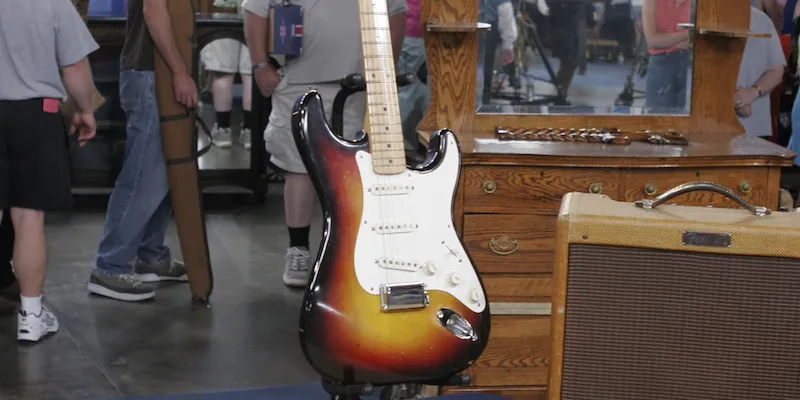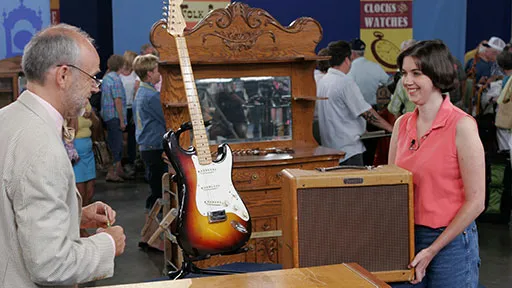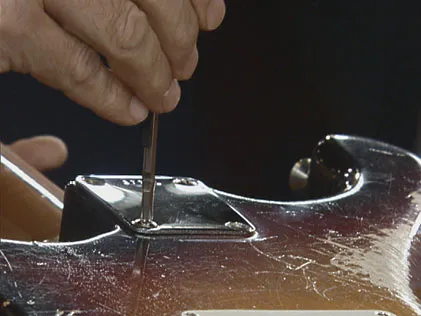Breaking Down Your Fender (Don't Try This at Home)
Is it really okay to take the neck off your Fender guitar?

Apr 14, 2006
At the Bismarck ANTIQUES ROADSHOW, Kerry Keane, working the musical instruments table, looked over a Fender Stratocaster, the guitar model that Eric Clapton, the British rock and blues guitarist, described to him once as "the perfect rock 'n' roll machine." Kerry, who works at Christie's East in New York City, had a number of clues that the guitar was assembled in 1959, including a stamped serial number on the neck plate of the guitar.

Fender Stratocaster—the "perfect rock 'n' roll machine"
"But the true way to really date the guitar," Kerry told the woman who brought in the instrument, "would be to pull the neck out and to read what might be either penciled or stamped here at the end of the finger board. ... With mass-produced items like Fender guitars, they're made of component parts. And one of the geniuses of Leo Fender's inventions was to bolt the neck on with four very simple bolts and a neck plate. It makes removing these extremely simple. And at the same time, it made for very easy repair when these instruments needed it."
But before he began taking out the screws from the plate to remove the guitar's neck, Kerry asked the woman for permission to operate. "We're going to sort of go somewhere where no one else has ever been," Kerry said, "if you're comfortable with that."
"I'm looking forward to it," she replied.

Keane was apparently the first person to take the screws off this Stratocaster (but don't worry, he's a professional).
Kerry then began removing the screws that held the guitar's neck to its body, raising a question for everyone who owns a Fender electric guitar: Is this a maneuver you should try on your own?
"My advice would be, 'Don't try this at home,'" Kerry told us. He had a good reason for urging caution. "The angle at which the neck is joined to the body is critical in maintaining the 'action,'" he said. "And the action is determined by the string height in relation to the fingerboard. If it's too low or too high, it's unplayable. And a very subtle change in angle can throw it off."
He's not exaggerating; more than once he says he has unscrewed a neck from a Fender guitar to find a few pieces of paper or a match cover stuffed in the joint — items that guitar assemblers added to make minor, but essential, adjustments in the angle of the neck. "So," he stressed, "the neck should only be removed by an experienced guitar repairman or technician."

After carefully separating the neck from the body, he found no pencil mark, suggesting this Fender was made in 1959.
Kerry, who has repaired instruments as well as appraised them, could tell by the tension as he turned the screws that they had never been removed before. "Whenever a specialist is looking for a mark, they like to know they're the first ones in," he says. "It's like we're opening up an old grave that hasn't been tampered with in the past." But he found no hidden date penciled in at the end of the neck. And there is good reason for that, too.
"It's a well-known fact that [in 1959] they dispensed with penciling in the dates," Kerry explains. "They went to a rubber stamp in 1960. Why? Well, there was rumor that there was a guy at the end of the production line and he was penciling in not the dates but profanity, and then bolting the necks together. Leo Fender heard about it, and said, 'Okay, you guys, no more writing the dates in pencils.'"
To find other identifying serial numbers, Kerry could have searched other parts of the guitar's innards by taking off the tremolo mechanism, for example, or removing the pick guard, or uncovering the vibrato cavity. But if he found out the guitar was made in 1958 or 1960 rather than 1959, would it have influenced the guitar's value? "The difference in value would be infinitesimal," Kerry said of the guitar and amp he appraised at roughly $25,000.
And if knowing the exact year doesn't affect the value, why bother disassembling the guitar to pin it down in the first place? ...
"We're nerds," he says of the people who appraise musical instruments — himself included. "We just want to know. Tell people I'm not embarrassed to admit I'm a guitar geek."


